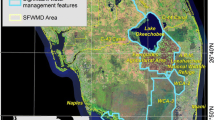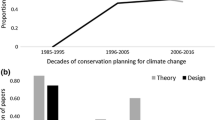Abstract
Managers were invited to attend the two-day “Predicting Ecological Changes in the Florida Everglades in a Future Climate Scenario” workshop and to participate in discussion and panel sessions. This paper provides a management perspective on the technical presentations presented at the workshop, identifying information of particular interest to Everglades restoration decision-making. In addition, the paper highlights the points related to science and decision-making that emerged from the discussion sessions and provides thoughts for future discussion in a follow-up forum. Particular focus is dedicated to the importance of and challenges associated with integrating science and decision-making. In addition, the paper offers a management perspective on the uncertainties of climate science and the implications they have for influencing Everglades restoration decision-making. The authors propose that on the one hand, even given uncertainties associated with predicting the ecological response to climate change, there remains a scientific consensus that Everglades restoration is generally on the right track. On the other hand, uncertainty can be a significant barrier to climate science influencing the implementation of restoration and adaptive management programs.
Similar content being viewed by others
Notes
For the purposes of this paper, the terms "manager" and "decision-maker" are determined to mean essentially the same thing, namely a person whose role in the Everglades restoration program comes with decision-making authority or influence or the responsibility to provide recommendations to decision-makers. People falling into this group include project and program managers, political appointees, elected officials and policy officials.
Design efforts typically do not include features required to manage the most extreme hydrologic conditions due to the high cost and low frequency of occurrence of those conditions.
The primary obstacles to integration of emerging climate science into decision-making involve organizational jurisdictions, budgeting priorities, and funding. It might be worth making a general statement here recognizing that it can be difficult to accurately assess to what extent science is influencing management when one considers all of the non-scientific factors that are weighed in management decisions.
References
Catano CP, Romañach SS, Beerens JM, Pearlstine LG, Brandt LA, Hart KM, Mazzotti FJ, Trexler JC (2014) Using scenario planning to evaluate the impacts of climate change on wildlife populations and communities in the Florida Everglades. Environ Manag. doi:10.1007/s00267-014-0397-5
Davis S, Ogden J (1994) Everglades: the ecosystem and its restoration. St. Lucie Press, Boca Raton
Florida Center for Environmental Studies Meeting Summary (2013) http://www.ces.fau.edu/climate_change/ecology-february-2013/Meeting-Summary.php. Accessed 12 Feb 2015
Glenn L (2012) Kissimmee River restoration project update to the governing board of the South Florida Water Management District. http://my.sfwmd.gov/paa_dad/docs/F1730588913/49_Kissimmee%20River%20Update%20-%20Glenn.pdf. Accessed 12 Feb 2013
Godfrey M, Catton T (2011) River of interests: water management in south Florida and the Everglades, 1948-2010. US Government Printing Office, Washington DC
Goodell J (2013) Goodbye. Rolling Stone, Issue, Miami 1186
Jones B, Colangelo D, Anderson D, Bousquin S, Cheek M, Carlson C, James T, Ibsen B, Mo C (2013) Kissimmee river restoration and basin initiatives. In: Draft 2014 South Florida environmental report. South Florida Water Management District. http://my.sfwmd.gov/portal/page/portal/xweb%20about%20us/agency%20reports. Accessed 12 Feb 2015
Keamey K, Butler M, Glazer R, Kelble C, Serafy EJ, Stabenau E (2014) Quantifying Florida Bay habitat suitability for fishes and invertebrates under climate change scenarios. Environ Manag. doi:10.1007/s00267-014-0336-5
National Research Council (2008) Progress toward restoring the Everglades, the 2nd Biennial review committee on independent scientific review of Everglades restoration. National Academies Press, Washington D.C
National Research Council (2010) Progress toward restoring the Everglades, the 3rd Biennial review committee on independent scientific review of Everglades restoration. National Academies Press, Washington D.C
National Research Council (2012) Progress toward restoring the Everglades, the 4th Biennial review committee on independent scientific review of Everglades restoration. National Academies Press, Washington D.C
Nungesser M, Saunders C, Coronado-Molina C, Obeysekera J, Johnson J, McVoy C, Benscoter B (2014) Potential effects of climate change on Florida’s Everglades. Environ Manag. doi:10.1007/s00267-014-0417-5
Obeysekera J, Barnes J, Nungesser M (2014) Climate sensitivity runs and regional hydrologic modeling for predicting the response of the greater Florida Everglades ecosystem to climate change. Environ Manag. doi:10.1007/s00267-014-0315-x
Orem WH, Newman S, Osborne T, Reddy R (2014) Projecting changes in Everglades soil biogeochemistry for carbon and other key elements to possible 2060 climate and hydrologic scenarios. Environ Manag. doi:10.1007/s00267-014-0381-0
Policansky D (1998) Science and decision making for water resources. Ecol Appl 8:610–618
South Florida Ecosystem Restoration Task Force (2012). South Florida ecosystem restoration task force 2010–2010 strategy and biennial report. http://issuu.com/evergladesrestoration/docs/2012_sbr?e=8031892/10200672. Accessed 12 Feb 2015
South Florida Ecosystem Restoration Task Force (2013). Meeting handouts and minutes http://www.evergladesrestoration.gov/content/tf/archives/tf_handouts_past_070913.html. Accessed 5 Feb 2015
South Florida Water Management District (2008). Water conservation: a comprehensive program for south Florida. http://www.sfwmd.gov/portal/page/portal/xrepository/sfwmd_repository_pdf/waterconservationplan.pdf. Accessed 8 Sep 2014
U.S. Army Corps of Engineers (1999). Central and southern Florida project comprehensive review study: final integrated feasibility report and programmatic environmental impact statement http://www.evergladesplan.org/pub/restudy_eis.aspx. Accessed 12 Feb 2015
US Army Corps of Engineers (2003) 33 CFR Part 385. Programmatic regulations for comprehensive Everglades restoration. http://www.evergladesplan.org/pm/progr_regs.aspx. Accessed 12 Feb 2015
U.S. Army Corps of Engineers and South Florida Water Management District (2010). Comprehensive Everglades restoration plan: Central and southern Florida project 2010 report to Congress http://www.evergladesplan.org/pm/program_docs/cerp_reports_congress.aspx. Accessed 12 Feb 2015
Water Resources Development Act Section 601 (2000) http://www.evergladesplan.org/wrda2000/wrda.aspx. Accessed 12 Feb 2015
Author information
Authors and Affiliations
Corresponding author
Rights and permissions
About this article
Cite this article
Estenoz, S., Bush, E. Everglades Restoration Science and Decision-Making in the Face of Climate Change: A Management Perspective. Environmental Management 55, 876–883 (2015). https://doi.org/10.1007/s00267-015-0452-x
Received:
Accepted:
Published:
Issue Date:
DOI: https://doi.org/10.1007/s00267-015-0452-x




